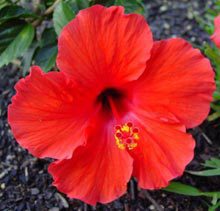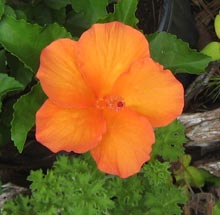 It’s that time of year again. The days are getting shorter and we know the cold weather is right around the corner, but here in the Lowcountry, we never know how long that block will be. There are parts of the country that actually have an average date for the first frost and gardeners can use this information to protect their gardens. Around here we just have to stay on our toes! But, that is a good thing; few parts of the country are blessed with the mild, temperate weather we usually experience this time of year.
It’s that time of year again. The days are getting shorter and we know the cold weather is right around the corner, but here in the Lowcountry, we never know how long that block will be. There are parts of the country that actually have an average date for the first frost and gardeners can use this information to protect their gardens. Around here we just have to stay on our toes! But, that is a good thing; few parts of the country are blessed with the mild, temperate weather we usually experience this time of year.
Much like with keeping track of the hurricanes, we just have to be prepared. Anticipating the cold and knowing which plants need protection are key. Waiting until the dire 11pm weather report then running outside in your jammies with the sheets and blankets to cover plants (like I often do) is not really proactive.
Sometimes you see the term “marginally hardy” on a plant label. This phrase means the plant might make it through the winter with modest protection, or sadly, some years it might not. Stashing these plants under trees, like our spreading Live Oaks, gives them a little advantage. The canopy of the low hanging branches helps to prevent frost from settling. This would be a good place for your marginally hardy plants. If the weather turns unusually cold like it did last winter, you might want to supplement the protection by throwing a blanket over them.
If you have some of the older-style mini Christmas lights, they give off just enough heat to protect tender or young trees. The newer LED lights are good for the environment, but provide little help to your plants because they do not give off any heat.
One thing I never use to protect plants is plastic, unless it can be removed first thing in the morning. Condensation can build up during the day and actually steam the plant. Also, if there is moisture under the plastic, it can freeze like an ice cube on the plant at night. Better to use frost cloth, available online, or recycled sheets and blankets, which breathe.
Your truly tender tropical plants – examples would be the Hibiscus rosa-senensis, bromeliads, crotons, orchids and most begonias – need the most protection and should be brought indoors. Before bringing in any plant material that has been outdoors, be sure to check for any insect infestation. Wash the plants carefully, using plain water or, if you find any bugs, an insecticidal soap which is available locally. This product is specially formulated for plants and has low toxicity, but always read and carefully follow the directions on the label. Some plants are known to be harmed by these products, and this will be noted on the label.
I pile a lot of my tender plants on a garden cart and roll them into the garage on the coldest nights; the rest of the time they sit in a sunny spot, protected from the wind, which can cause dehydration. Incidentally, a well hydrated plant is always healthier and better able to withstand the cold. The one-inch of water a week applies to the winter months too.
It is usually best to dig and store caladium bulbs as the foliage withers. Even though our soil does not freeze, it stays too damp for tender bulbs like these. Clemson recommends cleaning the bulbs and drying them for a week before storing. http://www.clemson.edu/extension/hgic/plants/landscape/flowers/hgic1160.html Some of the more tender cultivars of alsocasias and colocasias, the fancier Elephant Ears, also benefit from the same treatment.
The Camellias, both the Sasanquas and the Japonicas withstand cold well. Some open or nearly open flowers may turn brown from light frost but the tightly closed buds are fine. Open flowers can be protected from cold damage by covering the plant at night. My favorite Sasanqua, Leslie Ann, has just burst into bloom, I’ll be watching the weather carefully, I would hate for those flowers to be harmed.
Jack Frost is on his way so stay on your toes this month.
Read more How Does Your Garden Grow?








